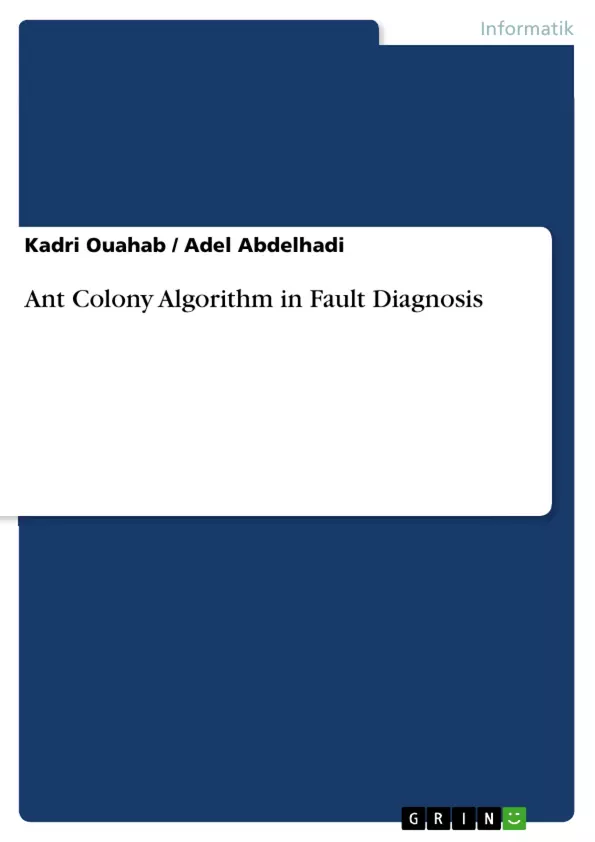In this book, we propose several modules of diagnosis for complex and dynamic systems. These modules are based on the three algorithms colony of ants, which are AntTreeStoch, Lumer & Faieta and Binary ant colony. These algorithms have been chosen for their simplicity and their vast field of application. However, these algorithms cannot be used under their basal form for the development of diagnostic modules since they have several limitations.
We have also proposed several adaptations in order that these algorithms can be used in diagnostic modules. We have proposed a parallel version of the algorithm AntTreeStoch based on a reactive multi-agents system. This version allows minimizing the influence of initial sort on the outcome of classification. We have also introduced a new parameter called Sid, which allows several ants to connect to the same position, and we have modified the movements of ants by promoting the path of the ant the most similar.
For the algorithm Lumer & Faieta, we have accelerated the speed of construction of classes by adding a speed setting different for each Ant. To reduce the number of movements, we have proposed a new variable that allows saving the identifiers of objects displaced by the same Ant. To improve the quality of classification, we have also added to the algorithm of the indices to report the classes trunks constructed. For the algorithm Binary ant colony, we have proposed a variant called "Hybrid wrapper/filter-based ACO-SVM".
This algorithm allows the selection of parameters. It combines the techniques of filters and enveloping methods in taking advantage of the rapidity of the Fisher report and the adaptation of selected settings to the classifier SVM. It improves the quality of classification according to the data nature in the database for learning and the type of the kernel function used. It also allows adjusting the hyperparameters of the kernel function. We tested these algorithms based on data from two industrial systems, which are the sintering system and the pasteurization system, as well on a few databases of UCI (University of California, Irvine).
Inhaltsverzeichnis
- Allgemeine Einleitung
- Kapitel 1: Fehlerdiagnose durch Mustererkennung
- Die verschiedenen Ansätze zur Diagnose
- Fehlerfindung durch Mustererkennung
- Das Grundprinzip
- Analyse von Beobachtungen
- Reduktion der Dimension des Darstellungsraumes
- Der Entscheidungsraum
- Die hierarchische Klassifizierung
- Die Klassifizierung durch Partitionierung
- Das Entscheidungsverfahren
- Die Verfahren der Entscheidung
- Parametrische Methoden
- Nicht-parametrische Methoden
- Direkte Berechnung von Grenzen
- Betriebsphase
- Die Bewertungskriterien
- Die Bewertungsmethoden
- Werkzeuge der Künstlichen Intelligenz für die industrielle Diagnose
- Neuronale Netze
- Die Fuzzy-Logik
- Schlussfolgerung
- Kapitel 2: Ameisenkolonie-Optimierung
- Einleitung
- Die echten Ameisen
- Grundprinzip
- Die Lösung komplexer Probleme
- Stigmergie
- Die künstlichen Ameisen
- Mehr-Agenten-Systeme
- Die Prinzipien von Datenbanken
- Die Agenten
- Architektur von Agenten
- Die reaktiven Architekturen
- Die kollektive Intelligenz von Ameisen
- Die Aufgabenverteilung
- Selbstorganisation
- Die Kommunikation
- Die akustische Kommunikation
- Die taktile Kommunikation
- Die visuelle Kommunikation
- Die chemische Kommunikation
- Die verschiedenen Anwendungsbereiche
- Ameisenkolonie-Algorithmen und die ADM
- Der Algorithmus AntTreeStoch
- Die Grundzüge
- Der Hauptalgorithmus von AntTreeStoch
- Der Fall einer Ameise auf der Klammer
- Der Fall einer Ameise, die auf einer anderen platziert ist
- Kritik und Grenzen des Basisalgorithmus
- Die Verbesserungen
- Der Algorithmus von Lumer & Faieta
- Die Grundzüge
- Kritik und Grenzen des Basisalgorithmus
- Verbesserung des Algorithmus
- Der binäre Algorithmus der Ameisenkolonie
- Kritik und Grenzen des Basisalgorithmus
- Verbesserung des Algorithmus
- Schlussfolgerung
- Kapitel 3: Support Vector Machine (SVM)
- Einleitung
- Geschichte
- Die SVM
- Die optimale Hyperebene
- SVM: Primale Formulierung
- SVM: Duale Formulierung
- Der Fall einer nicht-linear trennbaren Stichprobe
- Die Kernfunktionen
- Hyperparameter
- SVM Mehrklassen
- SVM: Einer gegen Alle
- SVM: Einer gegen
- DAG-SVM
- Die Regression durch SVM
- Software-Tools
- Schlussfolgerung
- Kapitel 4: Die Auswahlparameter für die industrielle Diagnose
- Einleitung
- Die Schritte zur Parameterauswahl
- Die Bewertungskriterien
- Die Fehlermaße der Klassifizierung
- Die Informationsmaße
- Die Konsistenzmaße
- Die Abhängigkeitsmaße
- Abstandsmessungen
- Die Filtermethoden
- Die Hüllenmethoden
- Fehlerdiagnose durch Mustererkennung
- Ameisenkolonie-Optimierung und ihre Anwendung in der industriellen Diagnose
- Support Vector Machines (SVM) und deren Integration in die Diagnose
- Parameterauswahl für die industrielle Diagnose
- Anwendungen in verschiedenen industriellen Systemen
Zielsetzung und Themenschwerpunkte
Dieses Buch befasst sich mit der Entwicklung von Diagnosemodulen für komplexe und dynamische Systeme. Die Autoren präsentieren verschiedene Ansätze, die auf dem Prinzip der Ameisenkolonie-Optimierung basieren. Das Ziel ist es, die bestehenden Algorithmen so anzupassen, dass sie für die Diagnose von industriellen Systemen eingesetzt werden können.
Zusammenfassung der Kapitel
Kapitel 1 erläutert die Grundlagen der Fehlerdiagnose durch Mustererkennung. Es werden verschiedene Ansätze, Methoden und Werkzeuge vorgestellt, die in der industriellen Diagnose eingesetzt werden. Kapitel 2 führt in die Ameisenkolonie-Optimierung ein. Es beschreibt die Funktionsweise der realen Ameisen und deren Anwendung in der künstlichen Intelligenz. Darüber hinaus werden die verschiedenen Algorithmen der Ameisenkolonie-Optimierung und ihre Einsatzmöglichkeiten in der industriellen Diagnose beleuchtet. Kapitel 3 behandelt die Support Vector Machines (SVM) und deren Anwendung in der industriellen Diagnose. Es wird die Funktionsweise der SVM erläutert und deren Integration in die Diagnosemodule dargestellt. Kapitel 4 schließlich widmet sich der Parameterauswahl für die industrielle Diagnose. Es werden verschiedene Methoden zur Auswahl geeigneter Parameter vorgestellt und deren Auswirkungen auf die Diagnosegenauigkeit diskutiert.
Schlüsselwörter
Die wichtigsten Schlüsselwörter und Themen dieses Buches sind Fehlerdiagnose, Mustererkennung, Ameisenkolonie-Algorithmen, Mehr-Agenten-Systeme, Support Vector Machines, Parameterauswahl und industrielle Anwendungen.
- Citar trabajo
- Kadri Ouahab (Autor), Adel Abdelhadi (Autor), 2016, Ant Colony Algorithm in Fault Diagnosis, Múnich, GRIN Verlag, https://www.grin.com/document/344694



